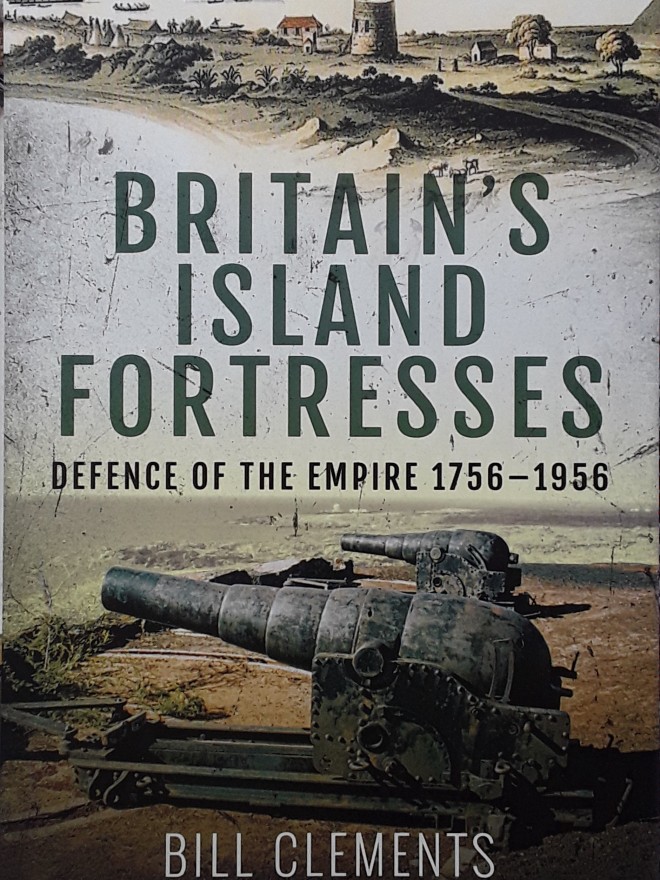
Reviewer: Michael Keith Rimmer
Title: Britain’s Island Fortresses: Defence of the Empire 1756-1956
Authors: Bill Clements
Total Number of Printed Pages: 274
Rating Scale (1: Very Poor, 10: Excellent): 8
__________________________
When writing within this volume’s Preface, and seeking to explain the raison d’être for what follows, the author notes that ‘The aim of this book has been to record the history and importance of a large number of British colonial fortifications’ with the intention being ‘…to bring to the reader’s attention this somewhat neglected area of historical research’. In this endeavour he has been largely successful.
Within the volume, a Preface placed immediately after the Contents page provides background to why it was written, while simultaneously acknowledging those individuals and organisations that assisted in its creation. It is followed by a 23-page Introduction. While this section summarises what appears within the nine Chapters which form the main part of the book, it also explores contemporary (Nineteenth Century) technical developments in the areas of warships, guns, fortifications and naval mining. The section also investigates the prevailing administrative structures associated with the defence of the military facilities described within the volume, although notably it gives no indication as to why the specific dates (1756-1956) appearing within the title were chosen. The main part of the book now appears. As previously-noted, this comprises nine Chapters, with each of these being focussed on a specific island within the (then) British Empire. Curiously (and for unexplained reasons), this list is not arranged alphabetically, with (for example) Antigua (Chapter 4) following St Helena (Chapter 3) instead in of the usual alphabetical order of ‘A’ preceding ‘S’. In a similar manner Singapore (Chapter 8) precedes Hong Kong (Chapter 9). It is an unusual arrangement which does not engender confidence in what is to follow. Within the individual Chapter, a standardised format is followed. This comprises a general history of the island followed in turn by a history and description of its defences and their history. Subsections within each Chapter provide more detailed information about a specific aspect of the larger narrative, their presence being indicated through the use of subheadings. Where appropriate within the Chapter, Photos, Maps, Plans and Diagrams are used compliment the narrative. These are accompanied by informative captions and source-indicating citations. The existence of the Photographs, Maps etc. is not mentioned in either the volume’s Index or on its Contents page. Where necessary, End-note-type Citations are used within the Chapters to provide additional information. These are numeric in sequence and Chapter-specific, with the necessary entries being placed in a designated Notes section located towards the rear of the book. Many of these citations are Quote-related, indicating the sources of the latter, yet it was noticeable that not all Quotes are referenced, with that appearing on page 221 being but one example of the latter. An Appendix (Artillery, Guns and Mortars) follows Chapter 9 (Hong Kong). It uses a Table format to describe the various artillery pieces mentioned within the volume, and is followed by the previously-mentioned Notes section. A Glossary follows. As the volume uses a variety of technical and military terms, acronyms and abbreviations to describe its subject, such a section is essential and informative. The Glossary is in turn followed by a Bibliography. Within this, the relevant titles have been grouped under the individual islands as they appear within the book; a helpful move. The Bibliography is followed by the volume’s Index; it’s last section.
While this volume is both informative and well-written, this reviewer found the Index to be problematical. Random searching revealed surprising ommissions, with the non-appearance of Index entries for entries for Shoeburyness (page 15) and Winnipeg Grenadiers, Stanley Mound, Chung Hum Kok and Tai Tam (all on page 245) being but five examples of what was found. There were others…! What else may be omitted cannot, of course, be known, and leads to doubts about the authority of the section, and ipso facto, the larger volume. In addition (and when selecting this volume for review), this reviewer was interested in learning why the specific date of 1956 appeared within its title. However (and as previously-noted), he searched its Introduction in vain for this information, and only when reading page 213 accidentally learnt that ‘On 31 December 1956 coast artillery in Britain and overseas ceased to exist’. That despite its prominence in the title, it took 213 pages to discover such a detail was surprising and when combined with the ‘difficulties’ with the Index did little to engender confidence in the volume’s veracity.
The ‘difficulties’ mentioned above notwithstanding, this volume is well-researched, well written and very readable and begs fair to become a ‘Standard Reference Work’ on its subject. Historians with an interest in the British Empire, British Empire defence and World Wars I and II may find it of interest, while military enthusiasts and hobbyists with an interest in both unusual fortifications and military operations of the Sixteenth – Twentieth Centuries may find it worthy of their attention.
On a Rating Scale where 1: Very Poor, 10: Excellent, I have given this volume an 8.
__________________________________



